Follow the Map
Follow the MAP In this article, I want to introduce you to the seldom-used diagnostic power of the Manifold Absolute Pressure sensor. After a class, a tech asked me to come by and look at a Dodge 1500 pickup with a P0305 code. They had a code reader as their primary tool The Question was, is there a quick way to determine which direction to take in the diagnostic procedure?
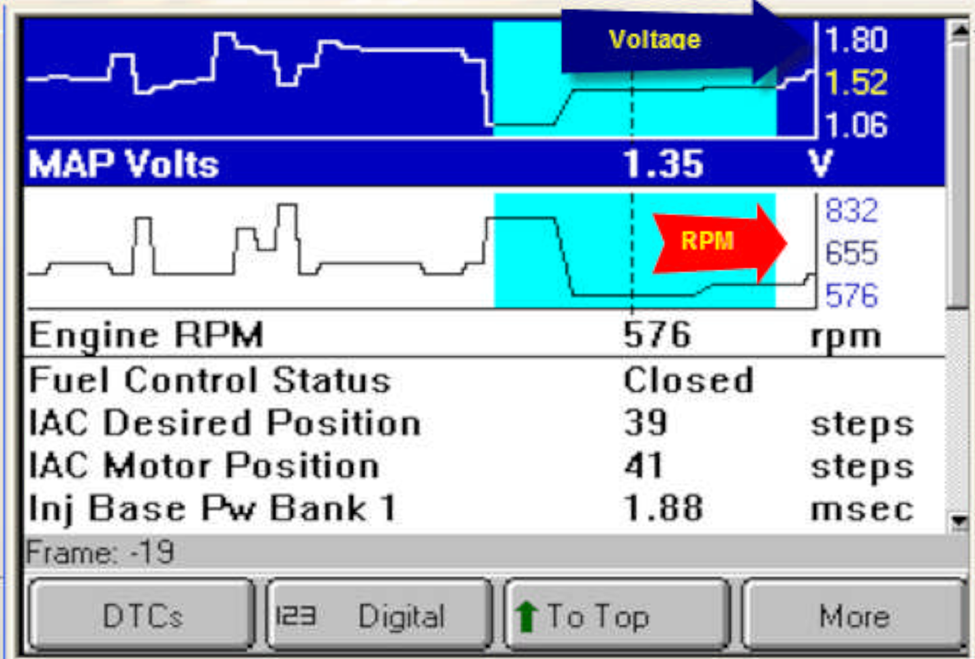
| Figure 1 Idle |
I hooked up my scan tool and saw the data on the screen in Figure 1. The idle is surging about 200 RPM. Normal idle should be steady with no more than 50 RPM variation. The MAP voltage readings should range between .9 to 1.5 Volts. This vehicle is high at times indicating pressure pulses in the intake. When there are erratic RPM and MAP sensor readings, it normally indicates an internal misfire condition due to improper sealing of the cylinder. The next step in the process is a cranking MAP sensor test. To get the best use of this test select only the MAP sensor and possibly the RPM readings for a quicker screen update. Pull the fuse or relay and run the engine till it dies, then crank the engine throttle closed. Figure 2 Cranking Notice the Pulses in the signal as the engine is cranking. The initial pull is close to three inches 29.23-26.58= 2.65. As we continue to crank the engine the pressure builds. These two tests indicate a mechanical problem with the engine, in this case, it turned out to be a cracked valve seat.
Figure 2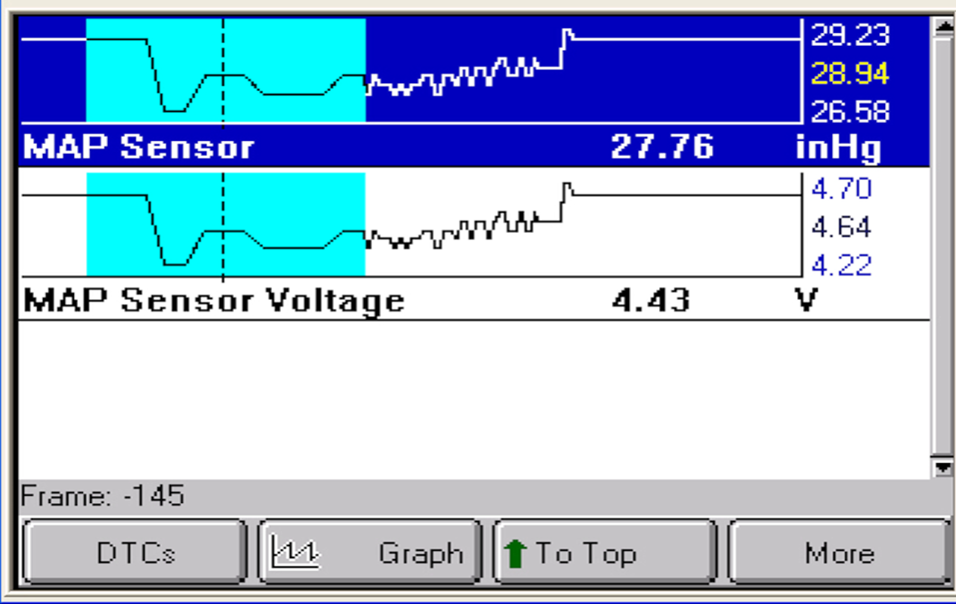
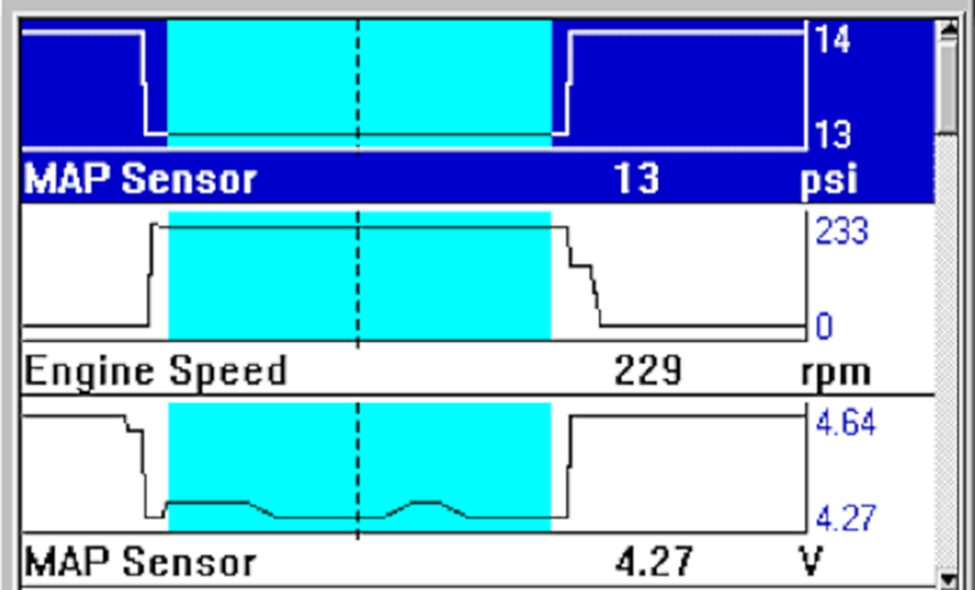 Figure 3 Cranking without a problem Figure 3 Cranking without a problem |
An example of good reading. Good cranking speed with a One PSI pressure change. To get the inches of vacuum multiply the number by two. This example has 2 inches of vacuum. A good engine will pull Three-Five inches of vacuum while cranking. On this example, it would be a good idea to plug off the idle air bypass and check again if needed. Let’s tie this together, to answer why not use a vacuum gauge, the first thing you can’t record the readings with a normal vacuum gauge. Vacuum gauge reads O key on engine off, and the MAP sensor reads 29.9 at sea level. Ever wonder why the vacuum gauge has a wide mark for 0, it is to allow changes in atmospheric pressure.
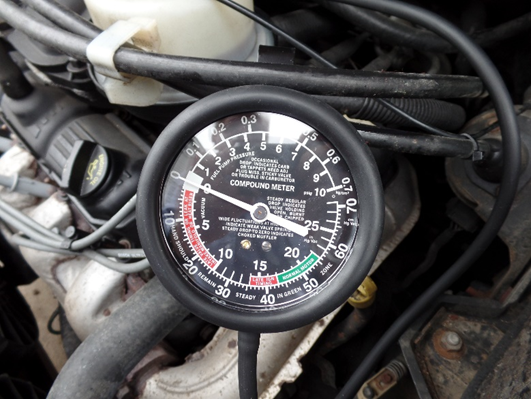 Figure 4 Vacuum Gauge engine off Figure 4 Vacuum Gauge engine off |
The vacuum gauge reads ”0” with the engine off. Figure 5 MAP/BARO Readings The Manifold Pressure sensor reads the BARO pressure at your altitude and weather conditions. Check with the local airport and not the weatherman to get the BARO/MAP readings and Altitude above sea level. If the MAP indicates the BARO, we can do use it as a pressure sensor for the intake manifold. Some vehicles use a separate BARO sensor mounted in the DME/PCM. Idle Readings are near 20 inches. Normal indicated readings for the engine. Key on MAP readings are 28.94, and idle readings are 8.86.
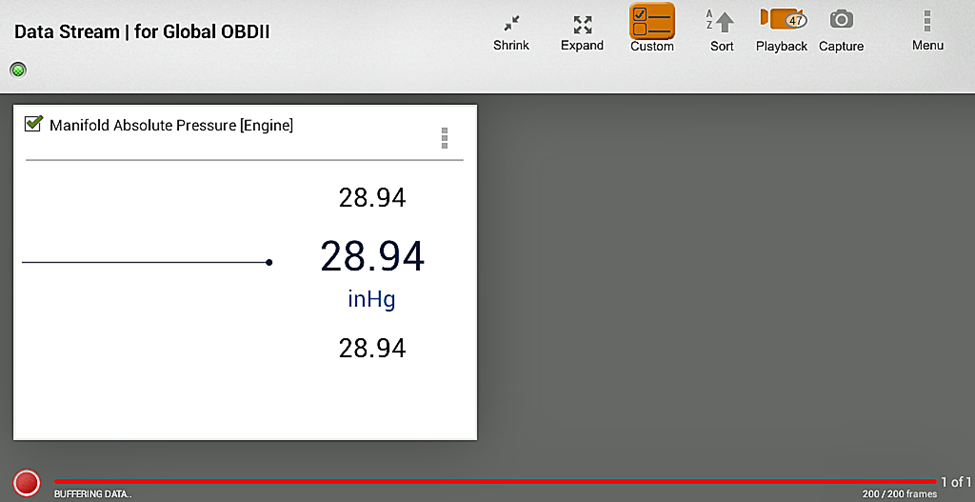 Figure 5
Figure 5
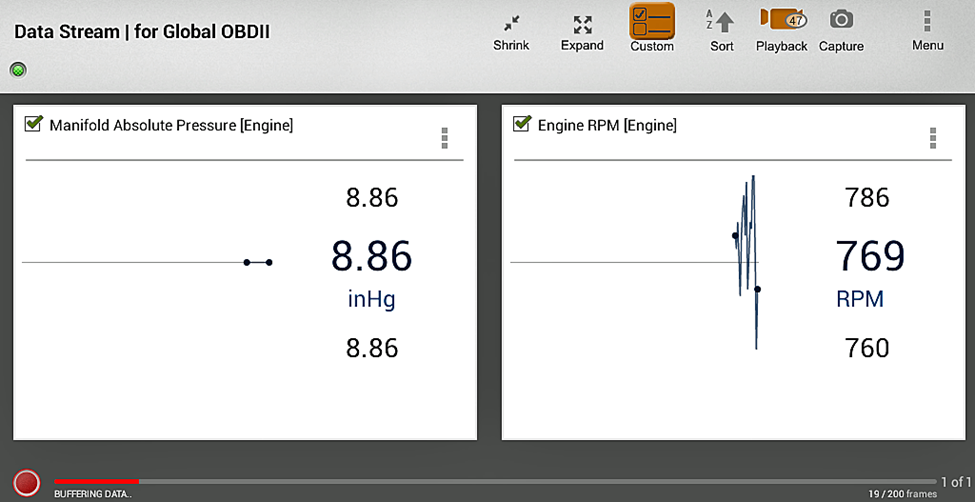 Figure 6 MAP and RPM Readings at idle Figure 6 MAP and RPM Readings at idle |
28.94 subtract 8.86 = 20.08 Map, and Vacuum agree so we have a good engine and MAP sensor Remember key on engine off you have atmospheric pressure in the intake manifold. But running the engine has a closed throttle which acts as a restriction and creates a negative pressure in the intake manifold. The opening and closing of the valves create positive pressure, but it is lower than atmospheric pressure.
| Figure 7 Air Flow and Pressure changes |
| Figure 9 Altitude BARO readings |
| Figure 8 GM MAP sensor readings chart |
Altitude readings are different, so check the readings key on engine off readings where you are. Looking at this chart, the readings for voltage used earlier to match the 18 to 21 inches on this chart. The MAP sensor reading will be between 8 to 12 inches. Find a chart for the vehicle you are working on if possible. Do you do Volumetric Efficiency testing? Add the BARO sensor to your recordings to get another indicator to use in diagnostics.
| Decrease in Pressure |
| Figure 10 BARO Pressure |
I had a Dodge Grand Caravan with a low power complaint, a road test at a wide-open throttle gave me the readings in figure 10. The BARO updates at wide-open throttle, and on this vehicle, it decreased indicating an intake restriction. In this case, a dirty air filter not replaced for a long time. Normal reading will be the same as the Key On engine off readings or go slightly higher.
| Figure 11 Good BARO Update |
| WOT |
| Throttle Closed Vacuum Increase |
| Figure 12 Snap Throttle test |
Snap the throttle should show a vacuum increase after the throttle closes if no increase is seen then a restricted exhaust, EGR, or valve timing issues could be the cause. I used an inexpensive lab scope for this test no reason to bring out the big boys tools. The recovery time from a closed throttle needs to be under three seconds.
| Figure 13 Using a MAP Sensor as a Transducer |
The MAP sensor can also be used as a transducer when you use a scope and set it to AC voltage. I hooked this to the vehicle using a Nine Volt battery as my voltage source. Now we can see the pulses of pressure in the intake manifold.
| Figure 14 MAP Transducer setup |
I have provided several ways to use the MAP/BARO sensor to give you a quick view of the engine condition. Use these steps to determine if you need to do further testing, I use this as a Triage tool, before bringing out my other more costly tools. Give it a try it might just save you some time. As a quick review if the MAP and RPM have an erratic or saw-tooth pattern look for an internal sealing problem. Another tip if MAP is steady and RPM is erratic or has a saw-tooth pattern, then look at the fuel trims. Fuel trims with 10 to 12% or so look for an external source of the misfire, higher then this look for a fuel related issue. Have Fun!
Follow the MAP In this article, I want to introduce you to the seldom-used diagnostic power of the Manifold Absolute Pressure sensor. After a class, a tech asked me to come by and look at a Dodge 1500 pickup with a P0305 code. They had a code reader as their primary tool The Question was, is there a quick way to determine which direction to take in the diagnostic procedure?
| Figure 1 Idle |
I hooked up my scan tool and saw the data on the screen in Figure 1. The idle is surging about 200 RPM. Normal idle should be steady with no more than 50 RPM variation. The MAP voltage readings should range between .9 to 1.5 Volts. This vehicle is high at times indicating pressure pulses in the intake. When there are erratic RPM and MAP sensor readings, it normally indicates an internal misfire condition due to improper sealing of the cylinder. The next step in the process is a cranking MAP sensor test. To get the best use of this test select only the MAP sensor and possibly the RPM readings for a quicker screen update. Pull the fuse or relay and run the engine till it dies, then crank the engine throttle closed. Figure 2 Cranking Notice the Pulses in the signal as the engine is cranking. The initial pull is close to three inches 29.23-26.58= 2.65. As we continue to crank the engine the pressure builds. These two tests indicate a mechanical problem with the engine, in this case, it turned out to be a cracked valve seat.
| Figure 3 Cranking without a problem |
An example of good reading. Good cranking speed with a One PSI pressure change. To get the inches of vacuum multiply the number by two. This example has 2 inches of vacuum. A good engine will pull Three-Five inches of vacuum while cranking. On this example, it would be a good idea to plug off the idle air bypass and check again if needed. Let’s tie this together, to answer why not use a vacuum gauge, the first thing you can’t record the readings with a normal vacuum gauge. Vacuum gauge reads O key on engine off, and the MAP sensor reads 29.9 at sea level. Ever wonder why the vacuum gauge has a wide mark for 0, it is to allow changes in atmospheric pressure.
| Figure 4 Vacuum Gauge engine off |
The vacuum gauge reads ”0” with the engine off. Figure 5 MAP/BARO Readings The Manifold Pressure sensor reads the BARO pressure at your altitude and weather conditions. Check with the local airport and not the weatherman to get the BARO/MAP readings and Altitude above sea level. If the MAP indicates the BARO, we can do use it as a pressure sensor for the intake manifold. Some vehicles use a separate BARO sensor mounted in the DME/PCM. Idle Readings are near 20 inches. Normal indicated readings for the engine. Key on MAP readings are 28.94, and idle readings are 8.86.
| Figure 6 MAP and RPM Readings at idle |
28.94 subtract 8.86 = 20.08 Map, and Vacuum agree so we have a good engine and MAP sensor Remember key on engine off you have atmospheric pressure in the intake manifold. But running the engine has a closed throttle which acts as a restriction and creates a negative pressure in the intake manifold. The opening and closing of the valves create positive pressure, but it is lower than atmospheric pressure.
| Figure 7 Air Flow and Pressure changes |
| Figure 9 Altitude BARO readings |
| Figure 8 GM MAP sensor readings chart |
Altitude readings are different, so check the readings key on engine off readings where you are. Looking at this chart, the readings for voltage used earlier to match the 18 to 21 inches on this chart. The MAP sensor reading will be between 8 to 12 inches. Find a chart for the vehicle you are working on if possible. Do you do Volumetric Efficiency testing? Add the BARO sensor to your recordings to get another indicator to use in diagnostics.
| Decrease in Pressure |
| Figure 10 BARO Pressure |
I had a Dodge Grand Caravan with a low power complaint, a road test at a wide-open throttle gave me the readings in figure 10. The BARO updates at wide-open throttle, and on this vehicle, it decreased indicating an intake restriction. In this case, a dirty air filter not replaced for a long time. Normal reading will be the same as the Key On engine off readings or go slightly higher.
| Figure 11 Good BARO Update |
| WOT |
| Throttle Closed Vacuum Increase |
| Figure 12 Snap Throttle test |
Snap the throttle should show a vacuum increase after the throttle closes if no increase is seen then a restricted exhaust, EGR, or valve timing issues could be the cause. I used an inexpensive lab scope for this test no reason to bring out the big boys tools. The recovery time from a closed throttle needs to be under three seconds.
| Figure 13 Using a MAP Sensor as a Transducer |
The MAP sensor can also be used as a transducer when you use a scope and set it to AC voltage. I hooked this to the vehicle using a Nine Volt battery as my voltage source. Now we can see the pulses of pressure in the intake manifold.
| Figure 14 MAP Transducer setup |
I have provided several ways to use the MAP/BARO sensor to give you a quick view of the engine condition. Use these steps to determine if you need to do further testing, I use this as a Triage tool, before bringing out my other more costly tools. Give it a try it might just save you some time. As a quick review if the MAP and RPM have an erratic or saw-tooth pattern look for an internal sealing problem. Another tip if MAP is steady and RPM is erratic or has a saw-tooth pattern, then look at the fuel trims. Fuel trims with 10 to 12% or so look for an external source of the misfire, higher then this look for a fuel related issue. Have Fun!